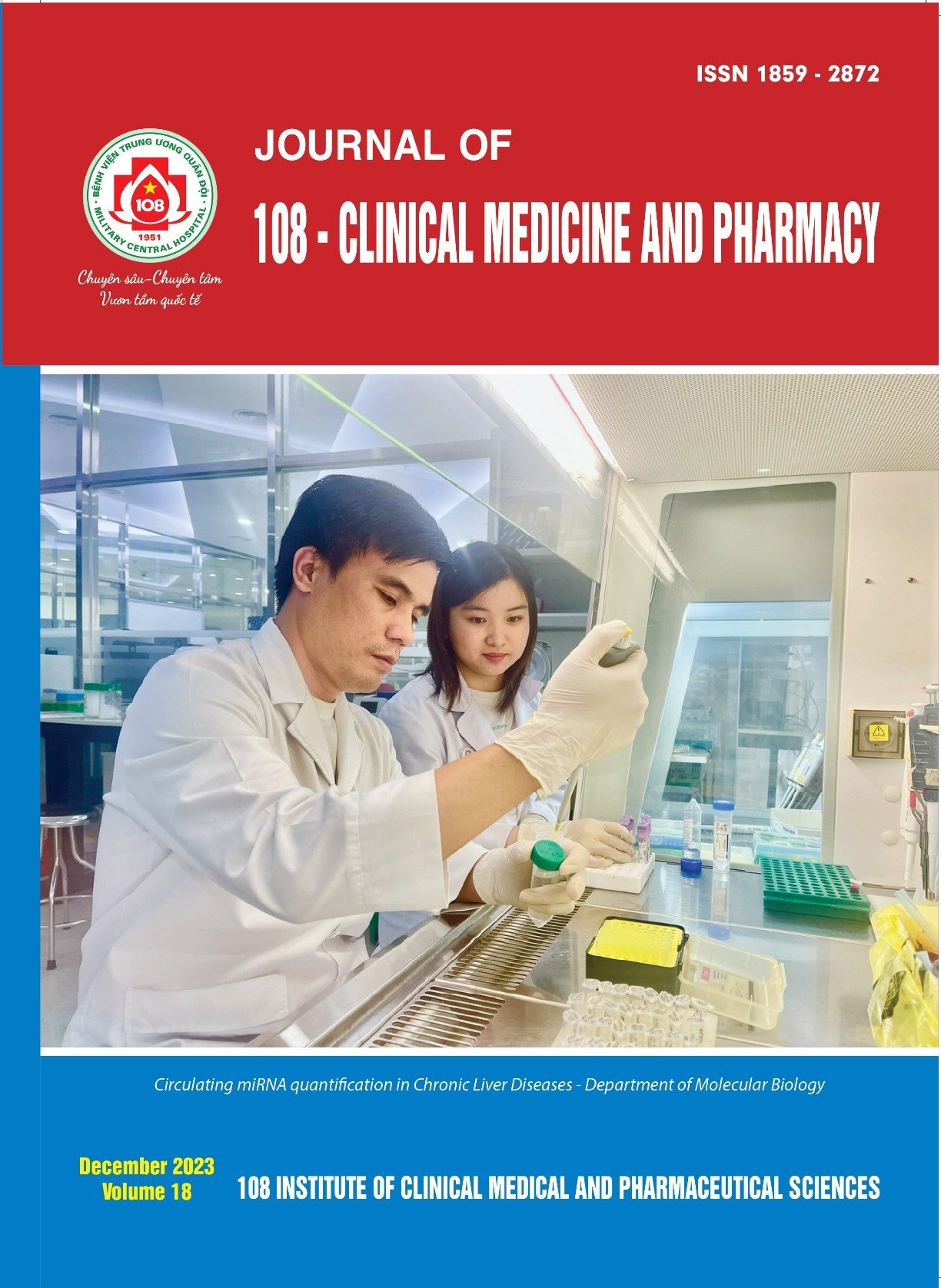Expression of circulating miRNA-21 and miR-99b in HBV-related liver cirrhosis and hepatocellular carcinoma
Main Article Content
Keywords
Tóm tắt
Objective: Our primary objective was to assess whether these miRNAs could serve as potential biomarkers for distinguishing hepatocellular carcinoma (HCC), even in its early stages, from other liver diseases, particularly liver cirrhosis (LC). Subject and method: We conducted a study involving two patient groups: 50 LC and 50 HCC patients. We employed a screening approach utilizing open data sources (PubMed, Science Research, Google Scholar…), alongside bioinformatics analysis tools to identify miRNAs exhibiting high expression levels in cirrhosis and liver cancer. The miRNAs we selected for evaluation included miRNA-21, miRNA-34a, miRNA-99b, and miRNA-224. Result: The expression levels of miRNA-21 in plasma were found to be significantly higher in the HCC group compared to the cirrhosis group (p<0.001). The combination of miRNA-21 or miRNA-99b and AFP had improved diagnostic performance in distinguishing between these two groups compared to single markers. The area under the ROC curve was significantly high as expected when combining miRNA-99b and AFP with AUC = 0.85 (single miRNA-99b: AUC = 0.715). Similarly for the combination of miRNA-21 and AFP, this simple panel also had a good performance with the AUC = 0.794 (single miRNA-21: AUC = 0.715). Conclusion: miRNA-21 and miRNA-99b hold promise as potential biomarkers for the diagnosis of HCC.
Article Details
Các tài liệu tham khảo
2. Jiang J, Gusev Y, Aderca I, Mettler TA, Nagorney DM, Brackett DJ, Roberts LR, Schmittgen TD (2008) Association of MicroRNA expression in hepatocellular carcinomas with hepatitis infection, cirrhosis, and patient survival. Clin Cancer Res 14(2):419-427. doi: 10.1158/1078-0432.CCR-07-0523.
3. Attwa MH, El-Etreby SA (2015) Guide for diagnosis and treatment of hepatocellular carcinoma. World J Hepatol. 7(12): 1632-1651. doi:10.4254/ wjh.v7.i12.1632.
4. Livak KJ, Schmittgen TD (2001) Analysis of relative gene expression data using real-time quantitative PCR and the 2(-Delta Delta C(T)) Method. Methods 25(4): 402-408. doi:10.1006/meth.2001.1262.
5. Wang X, Li J, Dong K et al (2015) Tumor suppressor miR-34a targets PD-L1 and functions as a potential immunotherapeutic target in acute myeloid leukemia. Cell Signal 27(3): 443-452. doi:10.1016/j.cellsig.2014.12.003.
6. Ratnasari N, Lestari P, Renovaldi D et al (2022) Potential plasma biomarkers: miRNA-29c, miRNA-21, and miRNA-155 in clinical progression of Hepatocellular Carcinoma patients. PLOS ONE. 17(2): 0263298. doi:10.1371/journal.pone.0263298.
7. Baskerville S, Bartel DP (2005) Microarray profiling of microRNAs reveals frequent coexpression with neighboring miRNAs and host genes. RNA 11(3): 241-247. doi:10.1261/rna.7240905.
8. Mishra PJ, Bertino JR (2009) MicroRNA polymorphisms: the future of pharmacogenomics, molecular epidemiology and individualized medicine. Pharmacogenomics 10(3): 399-416. doi: 10.2217/14622416.10.3.399.
9. Zhao J, Tang N, Wu K, Dai W, Ye C, Shi J, Zhang J, Ning B, Zeng X, Lin Y (2014) MiR-21 simultaneously regulates ERK1 signaling in HSC activation and hepatocyte EMT in hepatic fibrosis. PLoS One9(10):e108005. doi: 10.1371/journal.pone.0108005.
10. Wei J, Feng L, Li Z, Xu G, Fan X (2013) MicroRNA-21 activates hepatic stellate cells via PTEN/Akt signaling. Biomed Pharmacother 67(5): 387-392. doi:10.1016/j.biopha.2013.03.014
11. Qu J, Yang J, Chen M et al (2019) MicroRNA-21 as a diagnostic marker for hepatocellular carcinoma: A systematic review and meta-analysis. Pak J Med Sci 35(5): 1466-1471. doi:10.12669/pjms.35.5.685
12. Đặng Chiêu Dương (2020) Nghiên cứu biểu hiện microRNA-21, microRNA-122 huyết tương ở bệnh nhân ung thư biểu mô tế bào gan nhiễm vi rút viêm gan B. Luận án tiến sỹ, Học viện Quân y.
13. Malik J, Klammer M, Rolny V et al (2022) Comprehensive evaluation of microRNA as a biomarker for the diagnosis of hepatocellular carcinoma. World J Gastroenterol 28(29):3917-3933. doi:10.3748/wjg.v28.i29.3917.
14. Tat Trung N, Duong DC, Tong HV et al (2018) Optimisation of quantitative miRNA panels to consolidate the diagnostic surveillance of HBV-related hepatocellular carcinoma. PLoS One. 13(4): 0196081. doi:10.1371/journal.pone.0196081.
15. Tan Y, Ge G, Pan T et al (2014) A serum microRNA panel as potential biomarkers for hepatocellular carcinoma related with hepatitis B virus. PLoS One 9(9):107986. doi:10.1371/journal.pone.0107986
16. Lin Y, Deng W, Pang J et al (2017) The microRNA-99 family modulates hepatitis B virus replication by promoting IGF-1R/PI3K/Akt/mTOR/ULK1 signaling-induced autophagy. Cell Microbiol 19(5). doi:10.1111/cmi.12709.
 ISSN: 1859 - 2872
ISSN: 1859 - 2872
